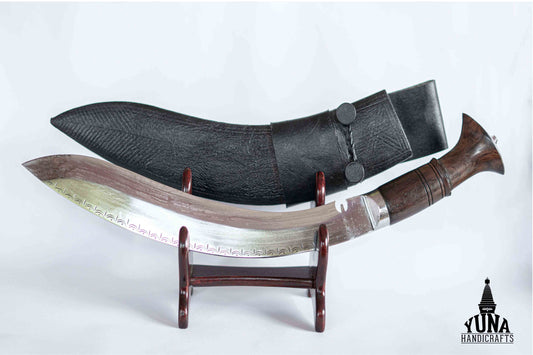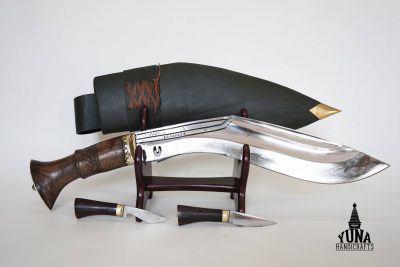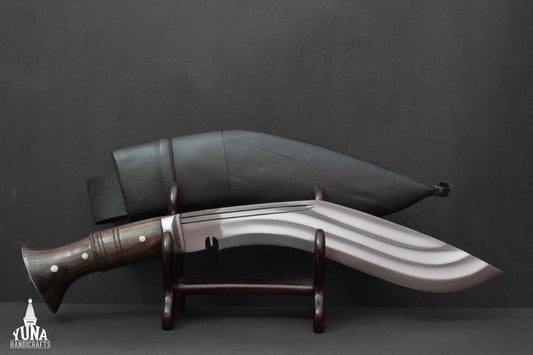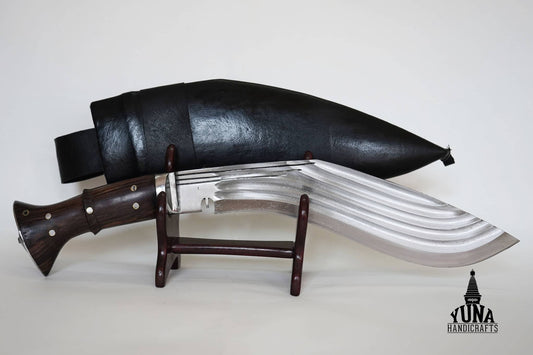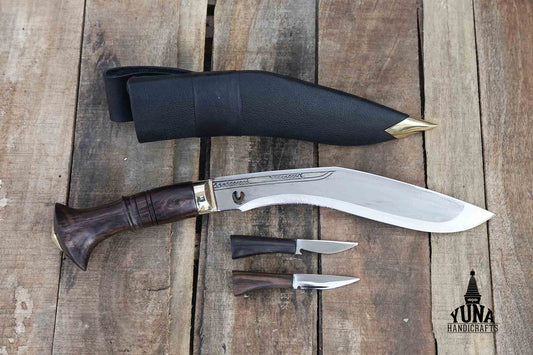
Sirupate Kukri Knife
Introduction to the Sirupate Kukri Knife
The Sirupate Kukri knife is a symbol of craftsmanship, tradition, and utility that traces its origins to the rugged terrains of Nepal. This iconic knife, known for its slender and graceful design, stands out among various Kukri variants due to its unique characteristics and deep cultural significance. Named after the "Siru" grass native to Nepal's hills, the Sirupate features a sleek, elongated blade that offers versatility for various tasks, from combat to everyday use.
Origins and Historical Significance
The Sirupate Kukri has been a vital tool and weapon for the Gurkhas, the legendary soldiers of Nepal. Historically, it was not only used in battle but also served as a multipurpose tool for chopping wood, clearing brush, and food preparation. Its lighter and more agile design made it particularly favored for speed and ease of handling in combat, cementing its place in military history alongside the broader Kukri family.
Design and Construction
Blade
The Sirupate Kukri is distinguished by its slender, slightly curved blade, typically ranging from 10 to 15 inches in length. Forged traditionally from high-carbon steel, it offers excellent hardness, edge retention, and durability. Modern variations may use stainless or Damascus steel. The subtle curvature gives it a sword-like appearance, optimized for slicing efficiency.
Handle
Handles are crafted from wood, horn, or bone, often intricately carved or adorned with metal fittings. The design ensures a comfortable and secure grip, crucial for both precision tasks and heavy-duty chopping.
Sheath
The knife is housed in a scabbard made of wood and leather, sometimes featuring metal embellishments. Many sheaths include small utility knives ("Karda" for small tasks and "Chakmak" for sharpening).
Cultural and Symbolic Value
In Nepalese culture, the Sirupate Kukri is a symbol of honor, bravery, and heritage. It is deeply embedded in rituals and traditions, often presented as a gift during weddings, festivals, and ceremonies. For Gurkhas, carrying a Kukri signifies pride and commitment to their warrior code. It is also believed to possess spiritual significance, warding off evil spirits, and is used in religious rituals.
Modern Utility and Collectibility
Today, the Sirupate Kukri remains popular among collectors, outdoor enthusiasts, and those appreciating fine craftsmanship. Its applications include:
-
Outdoor Activities: Ideal for camping, bushcraft, cutting vegetation, and food preparation due to its lightweight and sharp blade.
-
Self-Defense: Effective in close-quarters combat and martial arts due to its agility and sharpness.
-
Collectibility: Handmade, authentic Sirupate Kukris are valued as heirlooms and art pieces, with no two knives being identical.
Choosing the Right Sirupate Kukri
Consider these factors when selecting a Sirupate Kukri:
-
Blade Length: 10-12 inches for general tasks; longer for heavy-duty use.
-
Handle Material: Wood for tradition, horn/bone for aesthetics; choose based on environment.
-
Forging Technique: Hand-forged knives from Nepalese artisans offer higher quality and authenticity.
-
Sheath Quality: Ensure durability and secure fit, preferably leather or high-quality wood.
-
Authenticity: Purchase from reputable sellers or direct artisans to avoid imitations.
Care and Maintenance
Proper care ensures longevity:
-
Cleaning: Wipe blade dry after use; oil lightly to prevent rust.
-
Sharpening: Use a sharpening stone or Chakmak, maintaining the original edge angle.
-
Storage: Keep in a dry place; apply oil to the blade for long-term storage. Treat handles with oil/wax to prevent cracking.
-
Sheath: Ensure it is dry to avoid moisture trapping.
FAQs
1. What is a Sirupate Kukri knife?
A traditional Nepalese knife with a slender, curved blade, named after the "Siru" grass.
2. How does it differ from other Kukris?
It is slimmer and more elongated, making it lighter and more versatile.
3. What materials are used?
Blades are high-carbon steel; handles are wood, horn, or bone.
4. What are its common uses?
Chopping, clearing brush, food prep, self-defense, and outdoor activities.
5. Is it effective in combat?
Yes, historically used by Gurkhas for its agility and sharpness.
6. How do I sharpen it?
Use a sharpening stone or Chakmak, maintaining the original edge angle.
7. How should I care for it?
Clean after use, oil the blade, treat the handle, and store dry in its sheath.
8. Where can I buy an authentic one?
From reputable sellers or direct artisans in Nepal, seek certificates of authenticity.
9. What blade length is typical?
10-15 inches, depending on intended use.
10. What is the notch near the handle?
The "Cho" prevents blood from dripping onto the handle and symbolizes the goddess Kali.
11. Is it good for collectors?
Yes, due to its craftsmanship, history, and unique design.
12. How durable is it?
Extremely durable with proper care; can last generations.
13. Can it be used in survival situations?
Yes, for tasks like chopping wood, building shelters, and food preparation.
14. Are there customization options?
Yes, including engravings, handle materials, and decorative elements.
15. Why is it a symbol of the Gurkhas?
It embodies their courage, skill, and tenacity, used as both a tool and a weapon for centuries.
The Sirupate Kukri knife blends historical significance, cultural symbolism, and practical utility, making it a timeless piece for collectors, users, and admirers of Nepalese heritage.

